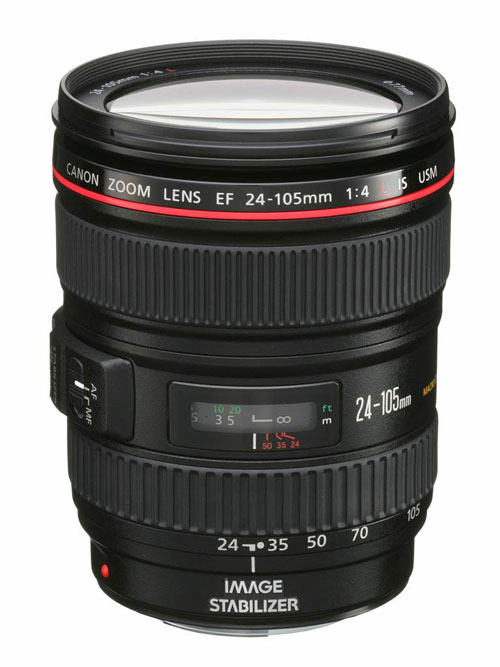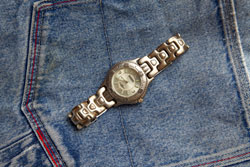Canon EF 24-105mm f/4L IS USM
Canon's EF 24-105mm f/4L IS USM is a popular choice amongst those after 'L' series lens quality, but with a decent zoom range. It costs around £785, which is quite reasonable for a marque pro spec lens covering this range. The savings probably come from the modest f/4 maximum aperture, but an Image Stabiliser is included to help in low light, so long as your subject isn't moving too quickly.
Alternatives include Canon's flagship standard zoom, the EF 24-70mm f/2.8 USM, which has a fantastic reputation for the quality it delivers and costs around £90 more at £875. Another alternative from lower down Canon's range is the venerable EF28-135mm f/3.5-5.6 IS USM, which costs around £360. This lens also has image stabilisation, an ultrasonic motor and extended telephoto reach over either Canon 'L' series lenses. Unfortunately you also sacrifice the useful 24mm wide angle and the brightness of the maximum aperture at the telephoto end.
None of the third party manufacturers currently do a direct alternative to this lens and many looking to make a purchase may be considering f/2.8 alternatives. Sigma's top line 24-70mm f/2.8 IF EX DG HSM has a bright maximum aperture, silent focusing and costs around £600. Tamron's current top line optic in this range is their SP 28-75mm f/2.8 XR Di, which costs a mere £360 but is much more basic in terms of specification, having no stabilisation and no silent focusing motor.
Canon EF 24-105mm f/4L IS USM: Handling and features
On the EOS 5D MkII used for testing, the weight of the EF 24-105mm f/4 balances perfectly. The outer barrel is constructed from high quality textured plastics, which all feel very rigid and sturdy while keeping the weight down. The fit and finish is to a very high standard with the textured finish being the type that will not show marks easily. Being one of Canon's 'L' series lenses it is also sealed against dust and moisture to help stand the rigours of daily professional use.
Focus is powered by ring-type ultrasonic motor, which allows for manual focus adjustments at any point. The autofocus is quick and precise at all points in the zoom range and as focus is performed internally, the front filter thread doesn't rotate, which should suit users of polarising filters. Zooming to 105mm extends the length of the lens by approximately 33mm and the supplied EW-83H lens hood moves with it, unlike on the EF 24-70mm f/2.8, where the hood stays put, making it more efficient at shading the lens due to its design.
Both the focus and zoom ring are quite narrow compared to more recent lens designs, but each are easy enough to operate with the zoom ring being lightly-weighted and the focus ring being damped. I had a few issues with zoom creep, but only around the 35mm setting, where the zoom mechanism becomes looser. Everywhere else in the zoom range seems to have plenty enough resistance to hold its position.
Canon promise that the image stabilisation system fitted to this lens should allow hand-held shooting at shutter speeds up to three stops slower than without. Putting this to the test, I had no problems taking shots at 1/13sec at 105mm, so I decided to try and push it further. Even at 1/6sec I was able to get a sharp shot of a static subject much of the time at 105mm. Maybe I just have really steady hands? Or maybe the Image Stabiliser does a better job than Canon advertise?
Overall I really enjoyed using this lens, mainly due to how well it balances on the camera used for testing, the fast and responsive focusing and excellent build quality.
Canon EF 24-105mm f/4L IS USM: Performance
During testing the EF 24-105mm f/4 performed well throughout the zoom range, especially in the centre at larger apertures. At 24mm and f/4 the resolution in the centre is already excellent, but the quality towards the edges lags behind a bit. Stopping down improves the quality towards the edges dramatically and peak quality across the frame is reached at f/8 here, where the resolution is excellent across the frame.
Zooming to 50mm reveals a similar, rather pleasant story. At f/4 the centre resolution is already excellent and the quality towards the edges is good. At 50mm peak quality across the frame is reached at f/5.6, where sharpness is excellent right across the frame.
And finally at 105mm. Here the centre resolution at maximum aperture is still very good, but the quality towards the edges has fallen away a little. As ever, stopping down improves matters and the best quality across the frame will be reached between f/8 and f/11 here, where the centre is excellent, and the quality towards the edges is good.
The levels of chromatic aberration recorded were quite a surprise, as I expected a little better from an 'L' series lens. At 24mm fringing can cover 0.86 pixel widths towards the edges. This should be acceptable in many cases, but may show in large prints with high contrast areas in the periphery. At f/4 zooming the lens to 50mm makes little difference to the amount of fringing, but at least stopping the lens down here seems to reduce the effect. Finally at 105mm, the levels of CA are slightly increased over the figures recorded at 50mm at every aperture setting. At f/4 CA exceeds one pixel width towards the edges, which will definitely be something to watch for in images with high contrast towards the edges.
Falloff is pretty well controlled at 24mm, with the corners only being 1.14stops darker than the image centre. Stopping down to f/5.6 results in visually uniform illumination. At 105mm the falloff of illumination towards the corners increases a little. Here the corners are 1.65stops darker than the image centre and stopping down to f/5.6 results in pretty much even illumination.
Considering the extended zoom range, I expected quite a bit of distortion at the wide end of the zoom. At 24mm Imatest recorded 6.06% barrel distortion, which may cause problems if straight lines are critical. At the telephoto end barrel distortion is replaced with 1.4% pincushion distortion. Luckily the distortion at both ends appears to be uniform, so should be easy to correct in image editing software afterwards.
Flare and ghosting doesn't appear to be much of an issue with this lens when the light source is in the frame. Even shooting into the light it is pretty resistant to flare and loss of contrast. When the light source is outside of the frame, it can sometimes result in a loss of contrast and a little flare. Using the hood supplied with the lens will help matters here, although it doesn't do as great a job of shielding the lens at the telephoto end as it does at the wide end.
 | DxOMark provides objective, independent, RAW-based image quality performance data for lenses and digital cameras to help you select the best equipment to meet your photographic needs. Visit the DxOMark website for tests performed on the Canon EF 24-105mm f/4L IS USM. |
Canon EF 24-105mm f/4L IS USM: Verdict
Canon's EF 24-105mm f/4L IS USM is a great all-round standard lens which, apart from covering a useful zoom range, delivers excellent sharpness and is built well enough to take the rigours of daily professional use.
Its only weakness appears to be in the amount of chromatic aberration present towards the edges, especially at 105mm, but this can be easily corrected in software and should only really show in very large prints.
The image stabiliser performed surprisingly well, especially as I'd had plenty of coffee to drink on the day of testing. The view through the viewfinder just appears rock-steady, which I think also aids composition and focusing.
If your style of shooting will benefit more from a larger zoom range, than a brighter aperture, this lens is most certainly worth a look. It seems like great value also for the performance and features you get for the price.
 |
| A great all-round standard lens for full-frame cameras. |
 Excellent resolution in the centre throughout the zoom range
Excellent resolution in the centre throughout the zoom range Excellent performance towards the edges when stopped down
Excellent performance towards the edges when stopped down Great Image Stabiliser
Great Image Stabiliser Good build quality
Good build quality Fast silent autofocus
Fast silent autofocusCanon EF 24-105mm f/4L IS USM: Cons
 CA levels towards edges throughout the zoom range a little high
CA levels towards edges throughout the zoom range a little high| FEATURES |  |
| HANDLING |  |
| PERFORMANCE |  |
| VALUE FOR MONEY |  |
| OVERALL |  |
Canon EF 24-105mm f/4L IS USM: Lens specification
| Price | £785.00 |
| Contact | www.canon.co.uk |
| Filter size | 77mm |
| Format | Full-frame |
| Construction | 18 elements in 13 groups |
| Angle-of-view | 84° - 23° 20' |
| 35mm equivalent focal length (on APS-C body) | 38-170mm |
| Internal focusing | Yes |
| Image stabilisation | Yes |
| Minimum focus | 45cm |
| Maximum aperture | f/4 |
| Minimum aperture | f/22 |
| Weight | 670g |
| Size | 83.5mm x 107mm |
| In the box | Lens hood |
The Canon EF 24-105mm f/4L IS USM costs around £785 and is available from Warehouse Express here:
Canon EF 24-105mm f/4L IS USM
The 24-105/4L is on my 5Dmk2 for 90% of the time. Delivers as expected. The Image Stabilizer is One Good Thing (tm). Only drawback is that the lens slowly pulls out automatically by its own weight, more so after much use. It is THE allround lens for me. (The other 10% is shared between a 200/2.8L and some Mamiya Sekor MF-lenses )
Add your message
Login required
Please login here or if you've not registered, you can register here. Registering is safe, quick and free.
Please login here or if you've not registered, you can register here. Registering is safe, quick and free.
photodo Stats
1102 lenses
428 MTF tests
74 in-depth photodo reviews
100+ users join each day
Help the lens community by reviewing or rating a lens today via our lens search
428 MTF tests
74 in-depth photodo reviews
100+ users join each day
Help the lens community by reviewing or rating a lens today via our lens search
Latest Lens Reviews
- Chinon 28mm f/2.8 Vintage Lens Review
- Canon EF 70-200mm f/4L IS II USM Lens Review
- Samyang AF 85mm f/1.4 EF Review
- Sigma 70mm f/2.8 DG Macro Art Review
- Samyang AF 24mm f/2.8 FE Review
- Meike 50mm f/1.7 Review
- Tamron 70-210mm f/4 Di VC USD Review
- Lensbaby Burnside 35mm f/2.8 Review
- Asahi Super Takumar 50mm f/1.4 Review
- Asahi Super-Multi-Coated Takumar 135mm f/3.5 Review









